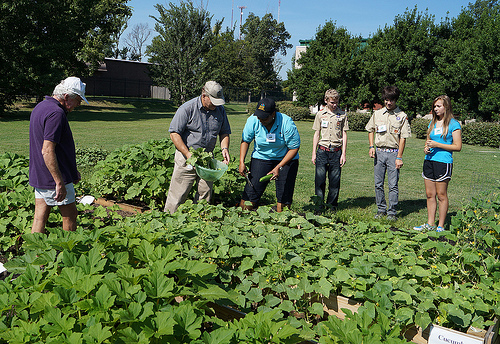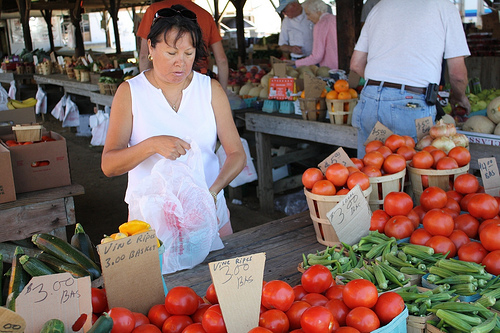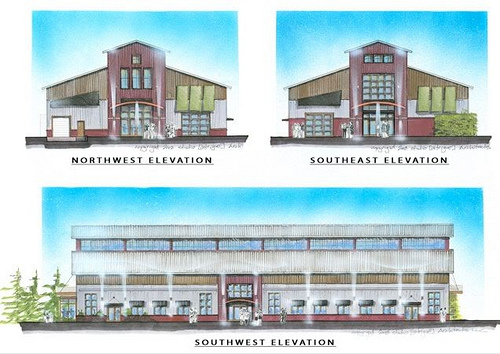
Harvest day at the Cotton Patch, a People’s Garden in Memphis, Tenn. The cucumbers, okra, radishes and squash harvested by USDA employees and community members are all donated to the Mid-South Food Bank. Photo courtesy Jeff Carnahan, Agricultural Marketing Service
This summer, the Cotton Division of USDA’s Agricultural Marketing Service (AMS) established a People’s Garden in Memphis, Tenn. The garden, suitably named “the Cotton Patch,” is a collaborative project developed and maintained by USDA employees and residents in the surrounding community. The exotic garden features raised vegetable beds and a colorful Japanese maple tree, as well as flower and rose gardens. Read more »
The USDA Market News Division of the Agricultural Marketing Service (AMS) works with various processors, buyers and brokers to track a wide variety of commodities. Since September 2010, USDA Market News has been reporting apple juice concentrate (AJC) prices as part of the National Apple Processing Report. This report also includes information on prices for apple varieties, shipments, and quantities utilized in the processing of apples on a weekly and yearly basis.
The Minneapolis Grain Exchange, a Designated Contract Market and Derivatives Clearing Organization, announced the official launch date for its new apple juice concentrate futures and options contract on August 13, 2012. The exchange developed the apple juice concentrate contract after thorough preparation and collaboration with many segments representing the apple juice industry as well as USDA, AMS, Fruit and Vegetable Market News. Read more »

Ladysmith Service Center employees with a Feds Feed Families donation. Left to right Rick Cote (FSA PT) – Sandy Voldberg(FSA-PT) – Mike Koehler(NRCS-DC) – Kathy Brihn(FSA-CED)
At over 1,600 field offices across the country, USDA employees are playing their part to help reach our 2012 Feds Feed Families goal of 1.8 million pounds of food. Feds Feeds Families seeks to help local food banks and pantries provide for their communities over the summer months—a time of year characterized by increased need and decreased giving. We are in the final month of this year’s drive and it is more important than ever to stay motivated to both reach our goal and help our neighbors in need. Read more »

A vendor places tomatoes into a plastic bag for a customer at a Maryland farmers market. Many beginning producers use farmers markets as the gateway to direct marketing opportunities. Photo by Elvert Barnes
This week we’ve celebrated farmers markets as a vibrant segment of U.S. agriculture that offers a unique and personal way to connect producers and consumers. We highlighted decades of farmers market participation, updated the status of farmers markets across the U.S., offered an example of innovation in the lessons learned by a market in Kentucky, and explained how structure and function interact through farmers market architecture. Now, with National Farmers Market Week coming to a close tomorrow, we thought we should share some perspective on how farmers markets fit into the larger local and regional food landscape. Read more »

A design concept for the outside of Michigan’s indoor/outdoor market arena. After developing a design concept, Fidel Delgado, AMS Architect, provides cost estimates and a feasibility assessment.
Farmers markets are evolving. They are moving away from seasonal, parking lot produce stands and becoming year-round, self-sustaining, community hubs. As more and more cities and communities look for ways to strengthen their local economies, we’ve seen more emphasis placed on both the infrastructure and the actual structure of their farmers markets. That’s where I come in. Read more »
For nearly 15 years, the Jeffersontown, KY, Farmers Market struggled. Dwindling to only four vendors selling to a handful of customers, the market was barely surviving from year to year. In 2009, the City of Jeffersontown found a recipe for success by combining the town’s enthusiasm and energy with support from USDA’s Farmers Market Promotion Program (FMPP) to reinvigorate and reinvent the farmers market.
FMPP is a competitive grant program administered by USDA’s Agricultural Marketing Service (AMS). The program provides funds to help establish, expand, and promote farmers markets, roadside stands, community-supported agriculture programs, and other direct-to-consumer marketing opportunities. FMPP has funded 443 diverse projects across the country since 2006. Read more »




